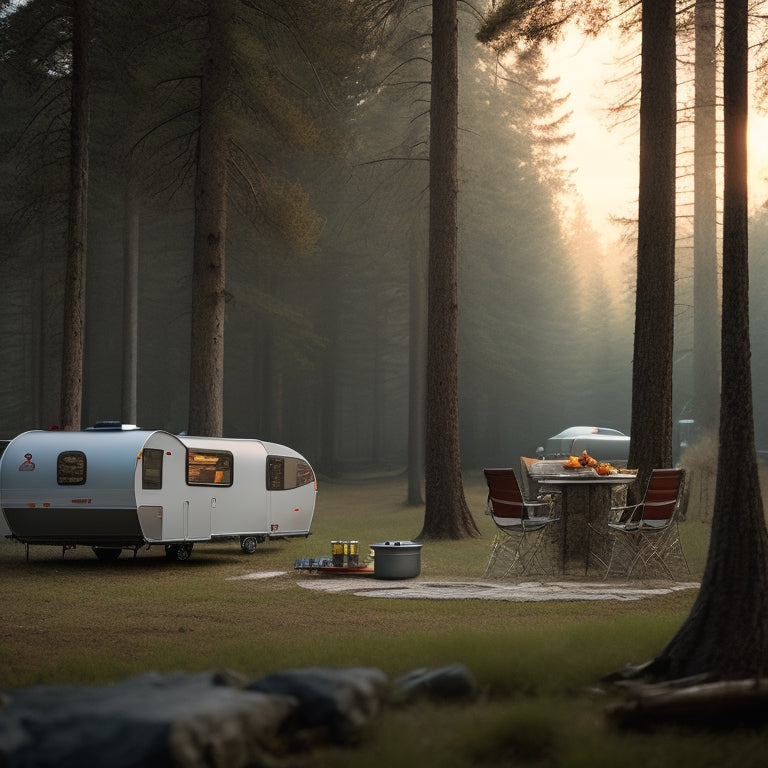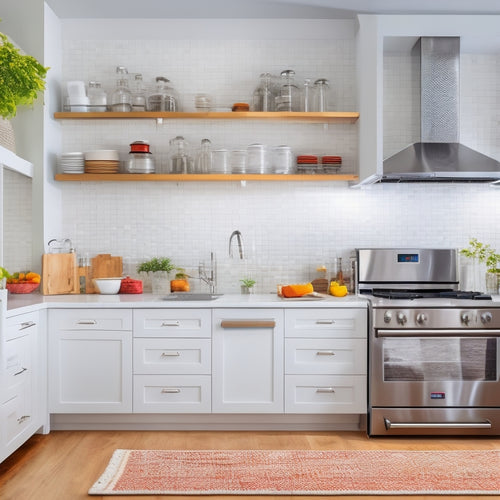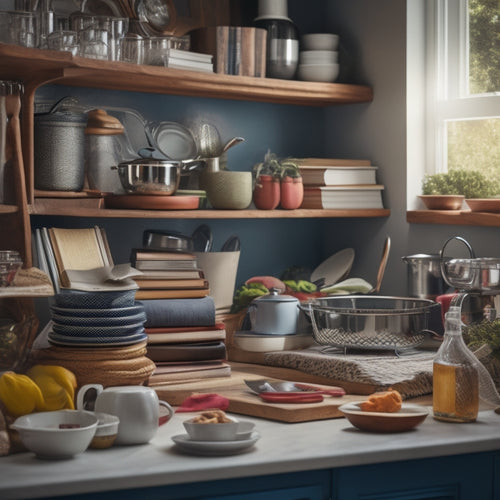
Ultimate Camp Kitchen Setup Secrets Unveiled
Share
We've perfected our camp kitchen setup through trial and error, and now we're spilling our secrets. Our ultimate setup combines efficiency, comfort, and sustainability. We start with the essentials: utensil organization, multi-use cooking utensils, and reusable options. Then, we choose the right cooking equipment and stoves for our camping style. Cleanup is a breeze with collapsible washing sets and biodegradable soap. We've also mastered the art of ambiance with canopies, camping chairs, and string lights. With our tips, you'll be well on your way to creating your own outdoor haven. Now, let's get into the nitty-gritty details that'll take your camp kitchen to the next level.
Key Takeaways
• Organize utensils in a designated tote with multi-use and reusable options for efficient camp kitchen setup and convenience.
• Select camp cooking equipment and stoves based on camping type and group size, ensuring proper stove maintenance and fuel supply.
• Implement a kitchen cleanup system with collapsible washing sets, biodegradable soap, and mesh storage to prevent animal access to food.
• Create a comfortable outdoor haven with a canopy shade, camping chairs, Thermacell Mosquito Repellent, and ambiance-enhancing string lights and Bluetooth speaker.
• Build your camp kitchen gradually, starting with bare necessities and refining your setup over time to suit your camping style and preferences.
Camp Kitchen Essentials
When it comes to setting up a camp kitchen, we've found that having the right essentials on hand can make all the difference in efficiency, convenience, and overall camping enjoyment.
One essential aspect is utensil organization. We like to keep our cooking utensils in a designated tote, making it easy to grab what we need when we need it.
A well-stocked camp kitchen should include a set of multi-use cooking utensils, such as a spatula, tongs, and a chef's knife. We also recommend bringing a set of reusable utensils, like silicone spoons and spatulas, to reduce waste.
Cooking Equipment and Stoves
We carefully select our camp cooking equipment and stoves, as they form the backbone of our outdoor culinary adventures. When choosing a stove, we consider the type of camping we'll be doing, the number of people in our group, and the fuel options available.
We recommend matching stove fuel to stove type for best performance and fuel safety. Regular stove maintenance is also essential to ensure reliability and efficiency. We also prioritize having extra fuel and lighters on hand, and invest in a reliable camping lighter.
Kitchen Cleanup and Organization
Having a well-organized camp kitchen includes a plan for cleaning up after meals, and that's where our attention turns now.
We've found that a collapsible camping washing set, dishwashing sponge, and biodegradable soap options like Mrs. Meyers or CampSuds make quick work of dirty dishes. A small mesh strainer and mesh bag come in handy for rinsing and storing utensils.
For utensil storage, we swear by clear reusable bags and smaller bins for easy access. Organizing items in sections and using clear plastic bins with locking lids prevent animals from accessing food and keep our kitchen tidy.
Additional Camp Kitchen Gear
Beyond the must-haves, we've found that a few nice-to-have items can elevate our camp kitchen from functional to fantastic.
A canopy shade, for instance, provides a comfortable spot to prep meals and escape the sun. Camping chairs are another luxury we can't live without - they're perfect for taking a load off after a long hike.
We also swear by a Thermacell Mosquito Repellent to keep those pesky bugs at bay. And, let's not forget about ambiance - string lights and a Bluetooth speaker can turn our campsite into a cozy oasis.
With these extras, we can transform our camp kitchen into a true outdoor haven. By investing in these additional gear, we can take our camping experience to the next level.
Building Your Camp Kitchen
As we begin constructing our camp kitchen, starting with the bare necessities is vital and gradually incorporating more items over time will help us refine our setup and prevent gear duplication. This approach allows us to identify what works best for our camping style and make budget-friendly upgrades. We've found that storage solutions are essential in keeping our kitchen organized and efficient. Here's a breakdown of our essential items and how we categorize them:
| Category | Essential Items | Storage Solution |
|---|---|---|
| Cooking | Stove, fuel, pot, utensils | Clear plastic bins with locking lids |
| Pantry | Food, snacks, condiments | Separate totes for each category |
| Eating | Plates, cups, silverware | Mesh bag with clear pockets |
Leave No Trace Principles
We adhere to the Leave No Trace Principles, a set of guidelines that guarantees our camp kitchen setup not only respects the environment but also minimizes our impact on the great outdoors. By following these principles, we make sure that our love for camping doesn't harm the very nature we're trying to connect with.
We plan ahead and prepare, traveling and camping on durable surfaces to avoid damaging the terrain. We dispose of waste properly, leaving what we find and minimizing campfire impacts. By adopting these sustainable practices, we uphold outdoor ethics and preserve the natural beauty of our camping spots.
Camp Kitchen Setup Strategies
With our commitment to Leave No Trace Principles in mind, we turn our attention to crafting a camp kitchen setup that's both functional and efficient, allowing us to focus on what really matters – enjoying the great outdoors.
We prioritize utensil storage, keeping our cooking essentials organized in totes and bins, making it easy to access what we need when we need it. By doing so, we can focus on perfecting our cooking techniques, whether it's whipping up a hearty breakfast or grilling a savory dinner.
A well-organized camp kitchen setup empowers us to cook with confidence, freeing us to savor the beauty of nature and create unforgettable camping memories.
Frequently Asked Questions
How Do I Secure My Camp Kitchen From Wildlife and Strong Winds?
We secure our camp kitchen from wildlife and strong winds by storing food and scented items in airtight containers, using wind-resistant setups, and storing equipment in locked bins to prevent unwanted visitors and damage.
Can I Use Regular Household Utensils and Cookware for Camping?
We're not trying to re-invent the kitchen wheel, but using regular household utensils and cookware for camping is like trying to fit a square peg into a round hole - it just doesn't fit. Instead, we opt for portable alternatives and lightweight options that are specifically designed for the great outdoors.
Are There Any Camp Kitchen Setup Options for Small or Solo Campers?
We solo campers prefer a compact setup, so we opt for a minimalist kitchen that prioritizes efficient cooking, leveraging space-saving gear like portable stoves and collapsible utensils to whip up a meal in no time.
How Do I Handle Food Waste and Disposal in a Camping Environment?
We prioritize eco-friendly food waste disposal by using biodegradable bags and composting tips, ensuring proper disposal and minimizing our camping footprint, while also exploring innovative solutions for responsible waste management.
What Are Some Camp Kitchen Hacks for Cooking in Extreme Weather Conditions?
"When the going gets tough, we get cooking! We adapt to extreme weather by using windshields for stoves, insulated pots for snow, and rain covers for gear, ensuring a hot meal despite Mother Nature's fury."
Related Posts
-

Optimize Your Kitchen Storage With 7 Simple Hacks
You're already wasting valuable kitchen space without realizing it, and it's likely due to a lack of strategic storag...
-

7 Best Kitchen Shelf Organizers for Heavy Cookbooks
You're looking for a kitchen shelf organizer that can handle your extensive collection of heavy cookbooks. You'll fin...

